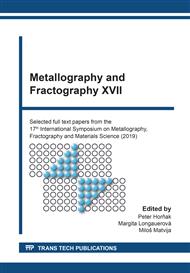p.324
p.333
p.339
p.345
p.351
p.357
p.365
p.373
p.379
Experimental Verification of Phase Diagram Calculations of Zr-Based Alloys after High-Temperature Oxidation
Abstract:
Zirconium-based alloys are commonly used as a material for nuclear fuel claddings in the light water reactors. The cladding material must function to fix a huge number of pellets, while conducting heat into the coolant that flows turbulently around the fuel rods. Cladding tubes can contain gaseous fission products that escape the fuel. Thus, by functioning as a sealed unit, it prevents a contamination of the coolant water with high-radioactive fission products. The integrity of claddings is always a critical issue during reactor operation and wet or dry storage and transport of the spent fuel rods. Moreover, the role gains importance at Loss of Coolant Accidents (LOCA). After Fukushima accident, cladding materials are widely studied with the purpose to reduce the high-temperature oxidation rate and enhance accident tolerance. In our contribution, we introduce the studies on Zr-1Nb (E110) cladding tubes after high-temperature steam oxidation at 1350 °C. During the testing of claddings, microscopy analytical methods play an important role in experimental verification of pseudo-binary phase diagram Zr1Nb-O, i. e. particularly in oxygen content determination at phase transitions. Wave Dispersive Spectroscopy (WDS) with complementary nano-indentation method were used to characterize the Zr1Nb microstructure formed after LOCA. It includes the regions from an oxide and oxygen-stabilized α-Zr(O) to the acicular prior β-Zr phase. The decrease of hardness and Young's modulus corresponds with oxygen content measured in line-profiles by WDS. The oxygen level at transition points was partly determined from Fe, Nb β-stabilizers and significant change in mechanical properties in fine-grained prior β-Zr. The slight fluctuation of oxygen values in adjacent grains can be caused by preferential oxidation through the favorably oriented α-Zr(O) grains studied by WDS+EBSD. As well, the non-uniform oxygen-rich α-Zr(O) phase adjacent to the oxide was characterized by EBSD & WDS. Increasing hydrogen content in specimens, 10, 700 and 1000 ppm H, caused increasing solubility of oxygen in prior β-Zr phase upon high-temperature and the cladding material hardening.
Info:
Periodical:
Pages:
351-356
Citation:
Online since:
November 2020
Keywords:
Price:
Сopyright:
© 2020 Trans Tech Publications Ltd. All Rights Reserved
Share:
Citation:


